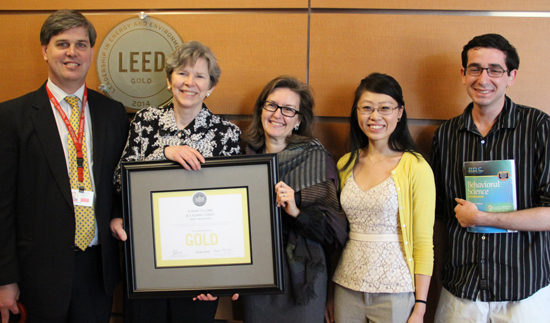Celebrating LEED Gold at the MSR

At a gathering of students, faculty and staff a plaque was unveiled celebrating the Medical Student Residence (MSR) official certification by the U.S. Green Building Council as LEED Gold.
“We are here to celebrate our LEED certification, which is a tribute to our Facilities department,” said BUSM Dean Karen Antman, MD. “They planned for sustainable design and construction because it is the right thing to do and that over the long term it is less expensive to run and maintain.”
LEED, an acronym for Leadership in Energy and Environmental Design, is an internationally-recognized green building certification system. Developed by the U.S. Green Building Council (USGBC) in March 2000, LEED provides a framework for identifying and implementing practical and measurable green building design, construction, operations and maintenance solutions. It promotes sustainable building and development practices.
This is the second building on the Medical Campus to achieve LEED certification. The first was 670 Albany Street in January 2008. Throughout the University eight buildings have been certified and this is the fifth to achieve Gold.
“The MSR is more than a building, it is a learning community for our students,” said BUSM Associate Dean for Student Affairs Angela Jackson, MD. “They walk together to class. They know each other so much better because they live here together. The MSR community has expanded to include Medical Campus students who use the Field of Dreams that surrounds the building for recreation and to grow vegetables in the garden.”
The MSR was designed and built with the goal of reducing waste sent to landfills, conserving energy and water, providing a healthier and safer indoor environment for its occupants, and reducing greenhouse gas emissions. Some highlights of the sustainable building strategies used at the MSR include:
- 18 percent more energy efficient than required by the building code
- Rainwater harvesting for landscape irrigation
- 40 percent water use reduction through efficient plumbing fixtures
- 88 percent of construction waste was recycled
- 33 percent recycled content of all construction material